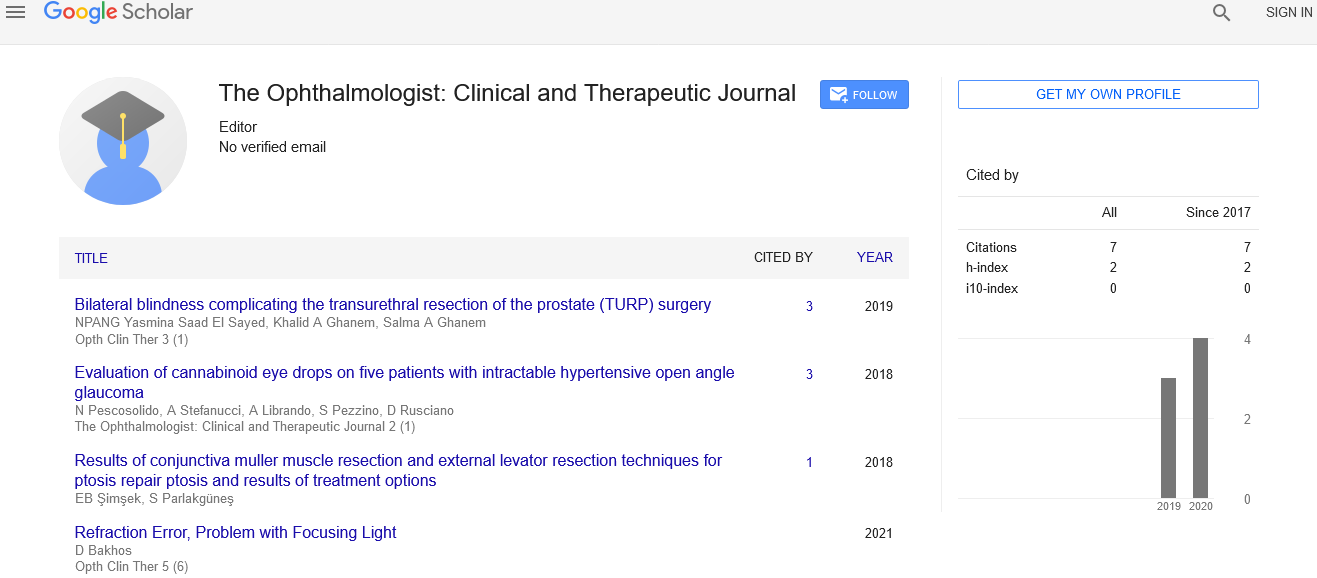Postoperative considerations and protection after cataract surgical procedure
Received: 07-Apr-2021 Accepted Date: Apr 21, 2021; Published: 28-Apr-2021
Citation: Chan H. Postoperative considerations and protection after cataract surgical procedure. Opth Clin Ther. 2021;5(2):9.
This open-access article is distributed under the terms of the Creative Commons Attribution Non-Commercial License (CC BY-NC) (http://creativecommons.org/licenses/by-nc/4.0/), which permits reuse, distribution and reproduction of the article, provided that the original work is properly cited and the reuse is restricted to noncommercial purposes. For commercial reuse, contact reprints@pulsus.com
Description
The purpose of this study is to provide a summary of current trends and recent developments in postoperative care after cataract surgery.
In the USA, cataracts affect about one in every six Americans older than 40 years of age. In those individuals who are older than 80 years of age, more than half have cataracts. Although surgery remains the definitive treatment, current trends in perioperative care continue to evolve with changing technologies, newer surgical techniques and ongoing research developments. Postoperative care after modern cataract surgery remains a critical element to ensure that each patient has the best visual outcome possible. It is the operating ophthalmologist's responsibility to follow patients during the postoperative period when most complications occur and within which stable visual function is achieved. Ethically, this obligation extends until postoperative visual rehabilitation is completed.
Key practices such as restrictions on activities, prophylactic regimens against infection and inflammation, appropriate follow-up with adjustments for individual risk factors and management of complications, and continuing care until visual rehabilitation is complete are advised to optimize visual outcome for patients after cataract surgery.
There is new evidence challenging the routine use of a protective eye shield after uncomplicated cataract surgery. Nonsteroidal Anti-Inflammatory Drugs (NSAIDs) are effective in decreasing the risk of Cystoid Macular Edema (CME) in high-risk eyes, but must be used with caution in patients with prior corneal disease. Pre-existing ocular comorbidities can have significant effects on postoperative outcomes. Management of postoperative visual expectations can be challenging in patients receiving newer advanced technology Intraocular Lenses (IOLs).
After uncomplicated cataract surgery, patients can generally be discharged from the recovery area once they are awake and alert with stable vital signs, demonstrate safe emergence from any anaesthetic or sedative agents given and report minimal or no pain. A plan for safe transport to the patient's home or other recovery location must be clear. Detailed written and verbal instructions must be given to the patient and any escort available with the patient. There should be a definite plan for a follow-up appointment and contact information to reach the operating physician and/or a designated medical partner who is qualified to care for the patient if that physician is unavailable.
Conclusion
Although postoperative care after cataract surgery can vary in practice, a similar goal of improved visual function is shared among all practitioners. Nearly all patients, including those with pre-existing conditions such as diabetic retinopathy or AMD, report significant improvements in vision and quality of life after surgery. In fact, a recent study looking at medicare beneficiaries aged 65 years and older with diagnosis of a cataract demonstrated that patients who had cataract surgery showed a lower risk of hip fracture within 1 year of surgery than those who had not had cataract surgery. In the postoperative period, activity restrictions and medication regimens should be designed to prevent possible complications. Effective follow-up should be flexible enough to accommodate for individual differences in patient progress. Future research should focus on outcome measures related to different activity and medication regimens. Studies to improve diagnostic and treatment modalities for possible complications would also be warranted.





